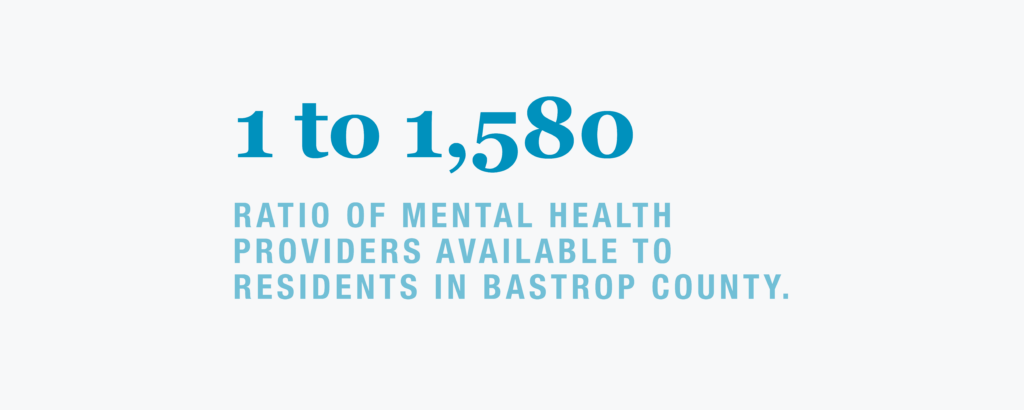Takeaway
The Issue
Bastrop County is growing rapidly and becoming less affordable. These two facts are impacting health care access and outcomes for underserved community members.
Bastrop County’s population grew 31.3% from 2010-2020 and Hispanic/Latinx residents accounted for 75% of the total population growth during this time. More than half the households in the county have insufficient assets and income to meet basic cost of living needs. Around 11% of Bastrop County lives below the poverty level and an additional 43% of households have limited assets and are income constrained despite being employed. Compared to their white counterparts, Black/African American and Hispanic/Latinx residents are more likely to live in poverty with 24.5% of the Black/African American population experiencing poverty, more than twice the rate of Hispanic/Latinx (11.9%) and white residents (9.2%). At the same time, housing costs have skyrocketed over the last decade. In fact, in one year (2020 to 2021), the median house price increased 32%, perpetuating the financial insecurity of residents. The result of these increased housing costs is undue burden on residents, who on average, spend 23% of their monthly income on housing and 11.1% spend more than 50% of their monthly income on housing, making other necessities like food, transportation, and health care cost prohibitive. On top of that, the COVID-19 pandemic-induced job losses further intensified housing and financial insecurity issues. Lastly, lack of transportation limits access to basic needs like health care and food, with 4.5% of households not owning a personal vehicle and some residents reporting 20-mile commutes to the closest grocery store, pharmacy, or doctor’s office.
All of these challenges exacerbate inequities especially as it pertains to Bastrop’s underserved, low-income, and minority community members. Many face lack of access to primary and specialty care, affordable care, and culturally- and linguistically-appropriate care. This is an issue that is compounded by a shortage of providers. The county has a been designated as a health professional shortage area for primary, dental and mental care. Due to the population growth, the number of residents per primary care physician grew 12.1% from 2010 to 2018. In addition, distance to receive affordable care as well as the cost of medication, create significant barriers to services for those that are financially insecure, some forgoing care entirely. The lack of culturally competent care where providers look and relate to like their patients’ concerns and realities, further impedes equitable access. Lastly, community members and leaders identified lack of insurance coverage as a key barrier to managing and treating conditions as 22.7% of residents under the age of 65 are uninsured.

Looking forward: Bastrop County has several community assets and strengths that serve as critical pillars to bolster the community’s resources, with strong churches, nonprofits, and schools to serve residents and meet unmet needs. It is home to two hospitals, five federally qualified health centers that provide primary and specialty care, several nonprofits that provide, health, education and social services, as well as multiple churches and faith-based organizations that support the homeless and participate in community outreach and advocacy initiatives.
The Findings
With the guidance of community members, there are three key recommendations that can help address these health-related needs and build on existing community assets.
One, improve access to health care. This means creating affordable health care by offering free or low-cost health care services like preventive health screenings. Also, increasing availability of transportation to health care by working with public transportation as well as providing mobile clinics with primary, mental health, and oral health care services. Educating and raising awareness about health through fitness and nutrition classes, cooking classes, and offering healthy grocery shopping lessons. And, offering health care services on-site at community events.
Two, increasing culturally competent health care through increasing the culturally competent workforce that provide compassionate and non-judgmental care as well as increasing the availability of language and translation services during appointments. Last, not requiring proof of identification or legal status documentation to receive care.
Third, strengthening engagement and outreach by reaching out to traditionally disadvantaged communities that are distrustful of institutions using trusted community members to regain and build trust as well as increasing community visibility with regular engagement to understand perspectives.
Through policy, system change, and collaboration with community partners, many of Bastrop’s health needs can be addressed and barriers can be reduced or eliminated altogether. Download the report below to learn more about the 2022 community health needs assessment findings for Bastrop County.